Most of my crew and I arrive over an hour before the call time. We want to get ahead, but frustratingly some kit issues hold us up. Given those issues, and that we didn’t get a pre-rig day due to Ben’s availability, the fact that we run only about an hour behind all day is pretty incredible. Ben, best boy Max, and sparks Mikey and Rudy have to run all the distro into and around the priory, and put up all the big HMIs outside the windows.
Once we get going we bash out the first scene very quickly: two set-ups, one take of each. We move into another room and more complicated scenes. The crucifix-shaped windows installed by the art department look great on camera, especially when we blast shafts of light through them. For one shot we mount one to C-stands and use it as a gobo. Several people have very complimentary things to say about the photography, which is a great relief!
Welcome hot food is served from the catering van – Christopher Lee Location Catering. You couldn’t make this stuff up. But when we wrap, the camera and lighting team somehow find ourselves standing in the road, eating leftover sandwiches by torchlight.
Last night I watched some of The Prestige and Perfume: The Story of a Murderer before going to bed. Tonight I look at the DVDs on the table and think: no, this film has become its own entity now. The game is afoot.
On set
Heretiks: Day 0
It’s the day before the shoot, and for me it’s very much the calm before the storm. My ACs Rupert and Max are busy in Cardiff prepping the camera gear, but I get a lie-in – my last for a while, I fear – before Paul and I are driven up to the remote location in the Brecon Beacons where we’ll be based for the first week and a half. When I arrive it’s wet and hellishly windy, but thanks to my thermals I’m toasty enough.
I spend a few quiet hours walking around the rooms we’ll be using, figuring out where we can put sources, and generally coming up with problems which poor Ben will have to solve! The art department are hard at work around me, and what they’re doing already looks great. There are crucifixes everywhere, and this gives me an idea… which I’ll talk about in a later post, if I end up going with it.
I read the American Cinematographer article on The Prestige. Christopher Nolan wanted a similar free-form, flowing camera style to that which Paul wants. Wally Pfister explained how he used minimal lighting, relied heavily on praticals, and pushed the film stock a stop to make this camera style workable. I shall steal his ideas.
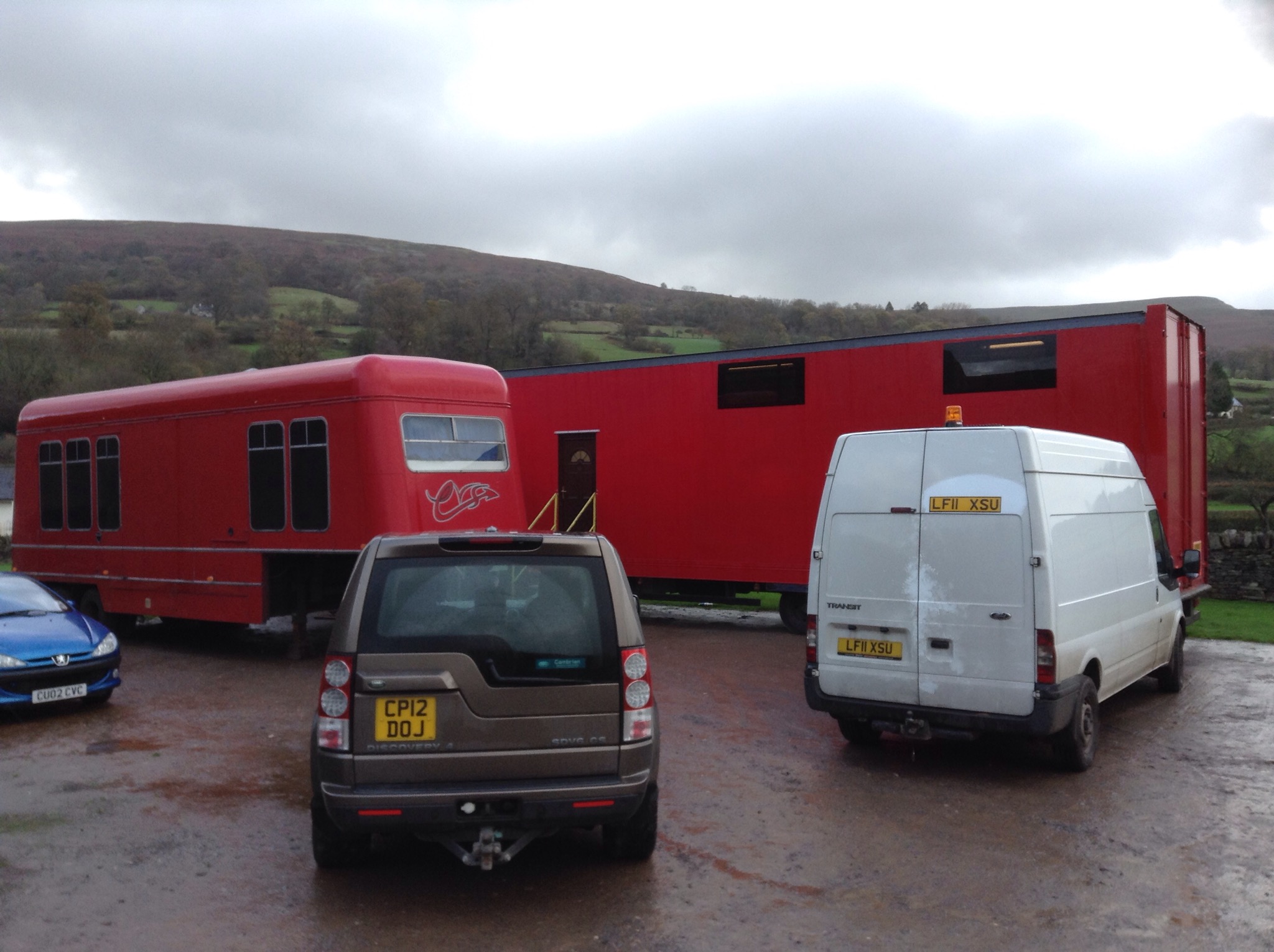
I pop into the massive costume trailer to meet the wardrobe supervisor, get my first glimpse at the clothes, ask what kind of headgear people will be wearing (which might shade their faces). Ben arrives just in time to see the location in the last of the daylight. He tests the genny and has a quick look over the lighting gear. I try to sort out a last-minute addition of a zoom lens to our camera kit.
Then I go to the cottage down the road where I’ll be staying for the next week and a half, along with the DIT, the line producer and the production manager. Other cast and crew are staying at neighbouring and less neighbouring cottages. It’s very nice, though there’s no phone signal or wifi. Which means you might be reading this quite a while after I wrote it, unless the pub we’re about to go to has wifi. Mmmm, pub.
Heretiks: Day -1
I eat breakfast at the hotel with the co-writer. We talk about dodgy Alan Moore adaptations and the perfection of Die Hard. When we get to the production office I’m still trying to figure out the lighting list, which is tricky because my gaffer is in transit from Poland! The office is in a castle, which is very cool but you have to go outside to make phone calls; the thick stone walls cut out all reception.
Paul is sitting doing storyboards, and he talks me through what he’s drawn for the first few days. They’re crude, but they give me an idea of how flexible I’ll have to be on lighting to accommodate the roving Steadicam moves he wants. I show him my blog post on 2.39:1 composition to see how he feels about things like short-siding, formal composition, squeezing people into the edges of frame. He’s up for all of it, which is great.
Julian, the production designer, takes me around the rooms we’ll be shooting in at the castle. We talk about where we can help each other out.
After lunch it’s time to set up for the make-up tests. An Alexa, the Cooke S4 primes, a monitor and some basic lighting gear has been delivered for this. I pick a room in the castle from which I can easily eliminate the natural light and while Rudy, my AC for the afternoon, sets up the camera, I establish a 3-point lighting set-up. We have three actors and four make-ups in total to test. I also want to test Soft FX filters and see if any of them will work for the show. We try different strengths (1/2, 1 and 2) on the first actor and quickly we all agree on 1/2. It gives the image a filmic softness without looking cheesy.
Leaving the 1/2 Soft FX in for the rest of the tests, I experiment with different lighting to see how the prosthetics and straight make-up react. I try four different keys: a 650W tungsten fresnel bounced from the side, the 650 bounced from above, the 650 direct and a kinoflo direct. I had issues on Ren with kinoflos causing shine, but here we seem to be fine. I test with and without fill, with hard and diffused backlights, and with bounce from below. We also look at cooler and warmer white balances to see how moonlight and candlelight will affect the make-up. What’s great about these tests is that I can play with the looks and get immediate feedback from Paul as he stands at the monitor. He really responds to the moodier looks, which makes me very happy.
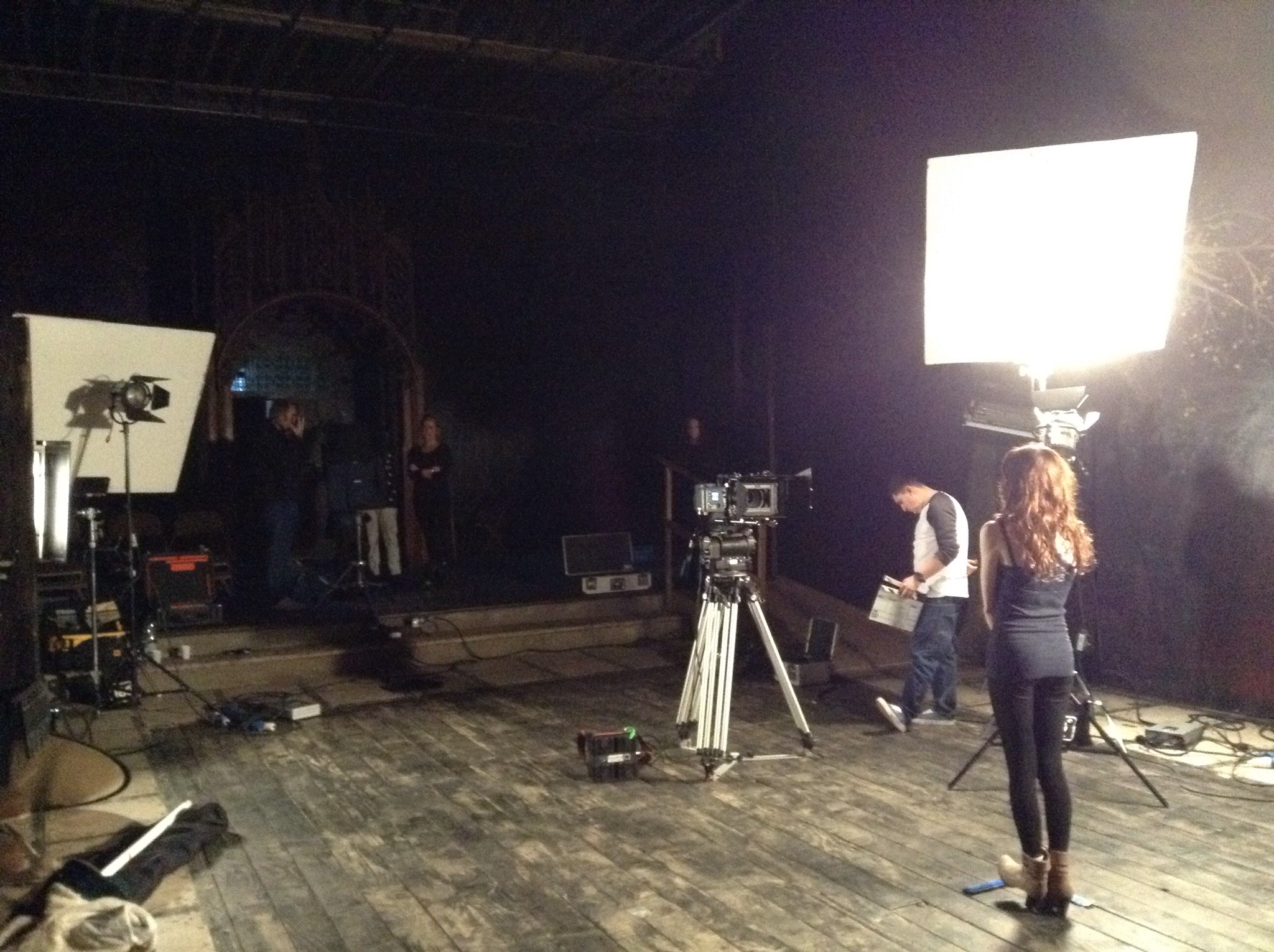
Heretiks: Day -2
Up at the crack of dawn to travel back to Wales, armed with a nice new warm coat, ski socks and thermals! On the train I read some relevant American Cinematographer articles and watch Ida. Stylistically it’s nothing like Heretiks will be, but I want to see how they handle some similar themes visually. It is as beautifully shot as everyone says it is.
I arrive at the production office…
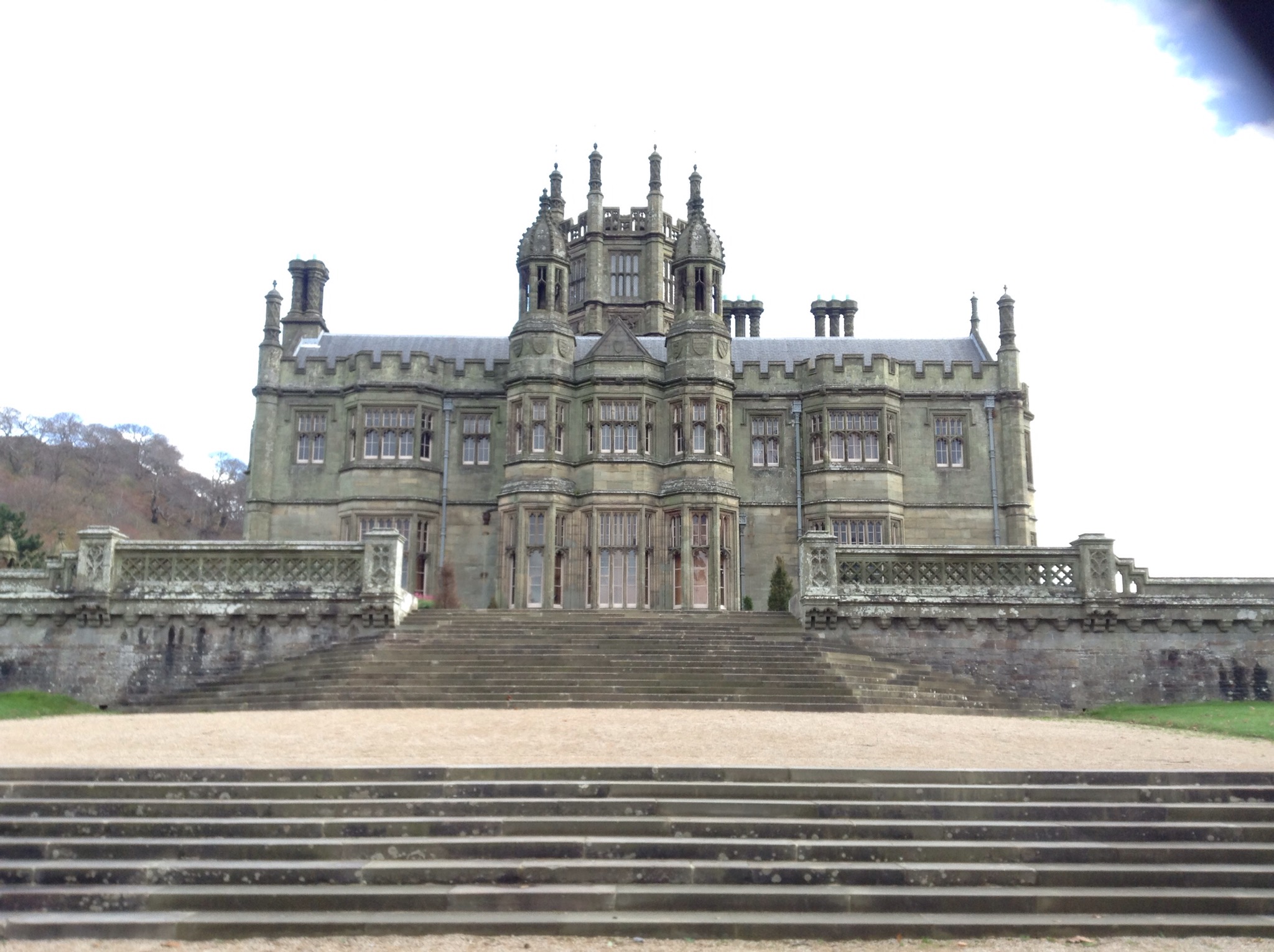
We have a big production meeting, going through the schedule day by day to address the concerns of the various departments. Naked flames vs. LED candles are discussed again. Having dealt extensively with the latter on The First Musketeer, I’m keen not to go down that route again. I get to see some initial make-up tests, and there’s lots of back-and-forth with me, Ben (the gaffer), the rental house and production about the lighting list, trying to get it down to a level that works for the budget and the size of our lighting crew.
Back at the hotel I write a risk assessment – urgh – apparently insurance companies expect these from all HoDs now. Dinner with one of the writers and one of the producers – they’re very nice, as is everyone on the team. Then I get to work on some lighting plans.
Heretiks: Hitting the Ground Running
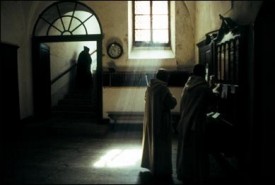 I just got hired last-minute to photograph a 17th Century supernatural thriller feature. At this stage I don’t know how much time I’ll have and how much I’ll be allowed to say about it, but I thought I would try a daily blog. It might make a nice change to “bring you along” on a shoot. So let’s dive right in.
I just got hired last-minute to photograph a 17th Century supernatural thriller feature. At this stage I don’t know how much time I’ll have and how much I’ll be allowed to say about it, but I thought I would try a daily blog. It might make a nice change to “bring you along” on a shoot. So let’s dive right in.
November 11th
I’m one of several DPs to meet with Paul, the director, about the project. Since first being contacted about it yesterday (sound recordist David kindly recommended me) I’ve only had time to read the script, watch the trailers for Paul’s last two films and do a quick google for some reference images. Several of those images are from The Devil’s Backbone, a film that sprung to mind as I read the script for Heretiks. Another image is the one in this post. I love the idea of the God rays coming in but not hitting the characters; they’re trying to be divine but falling short. I suggest to Paul that this could be a visual theme, and he seems enthusiastic. The meeting goes very well.
Paul’s keen on using a lot of Steadicam, so even though I haven’t got the gig yet I call Rupert (my 1st AC and Steadicam op on Exile Incessant) and sound him out.
November 12th
Mid-morning I get a call from the producer, offering me the job. I immediately confirm Rupert and spend the next few hours trying to fill out the rest of the camera, grip and lighting crew. After a brief discussion with Paul about shooting format, we quickly settle on the Alexa. I call the rental house, 180 Degrees in Bristol, to introduce myself, confirm the camera package and Cooke S4 lenses, and add an extra item or two.
Around 5pm I set off for South Wales, to be ready for tech scouts the next day. Rammed into a rush-hour train from Paddington, I go through a hardcopy of the script with a biro and two highlighter pens: blue for lighting, pink for camera. I also compile a character cheat sheet, because the script has a lot of characters and I know I’ll get them mixed up otherwise. It will also help to track their journeys through the story.
November 13th
I wake up to a wet, windy and bitterly cold Welsh morning. I’m going to need to buy thermal underwear before the shoot starts. A dozen of us pile into a minibus and drive to the first of our two main locations. As Paul talks everyone through the scenes, I struggle to keep up, being less familiar with the script than the others, some of whom have already been on the project for weeks. We don’t have a gaffer for the shoot yet, but a friend of the production manager’s has come along to draw up a lighting list. I’m also liasing with the effects supervisor and the production designer as we consider the requirements of each room. The first location is home to a protected bat colony, so only a specific type of bat-friendly smoke can be used.
After a very welcome pub dinner, we proceed to the second location. By this time it’s much clearer what Paul and Justin (the production designer) are aiming for. I can’t wait to see Justin’s plans come to life. When the recce is finished, we go through the schedule to determine which days will require naked flames – requiring an additional effects person on set. Then I head home, finishing my script mark-up on the way. I have the weekend off, then it’s back to Wales on Monday to start prep in earnest.
A Day in the Life of a DP
What does a cinematographer’s working day look like? Here’s a snapshot of last Wednesday, the fifth shooting day of six on a short film in south London. It’s a split day, with one daylight and one night scene scheduled, so the call time is 2pm.
 1:48pm As the cast and crew begin to arrive (I’m being accommodated at the location, conveniently) I check my notes for the upcoming scene. These were written during my second reading of the script, a few weeks previously, and include my thoughts and ideas on camerawork and lighting.
1:48pm As the cast and crew begin to arrive (I’m being accommodated at the location, conveniently) I check my notes for the upcoming scene. These were written during my second reading of the script, a few weeks previously, and include my thoughts and ideas on camerawork and lighting.
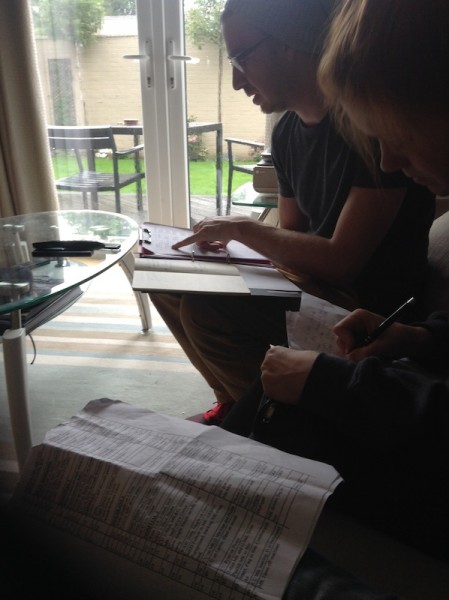 1:54pm I sit down with James the director and Mari the 1st AD to decide what order the day’s set-ups will be shot in. Generally shots are grouped by the rough direction the camera is pointing in, to minimise lighting resets.
1:54pm I sit down with James the director and Mari the 1st AD to decide what order the day’s set-ups will be shot in. Generally shots are grouped by the rough direction the camera is pointing in, to minimise lighting resets.
 2:13pm Mari assembles the crew to watch a block through of the scene, so everyone knows what they’re doing. Using Artemis, the virtual viewfinder app, James and I select the lens and camera positions for the first set-up. It’s a Steadicam shot, so my 1st AC and Steadicam operator Rupert is in on this conversation.
2:13pm Mari assembles the crew to watch a block through of the scene, so everyone knows what they’re doing. Using Artemis, the virtual viewfinder app, James and I select the lens and camera positions for the first set-up. It’s a Steadicam shot, so my 1st AC and Steadicam operator Rupert is in on this conversation.
 2:24pm The cast go into make-up and it’s time for my department to swing into action.
2:24pm The cast go into make-up and it’s time for my department to swing into action.
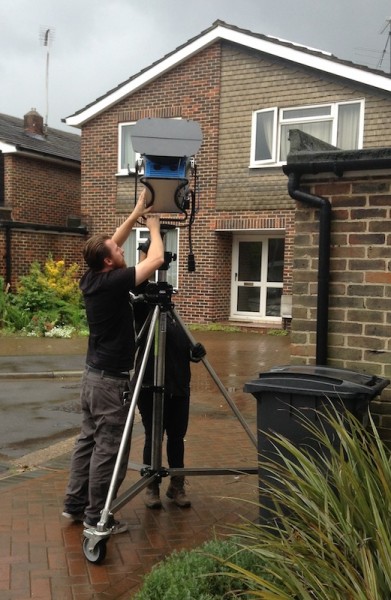 2:26pm On the recce the previous week I had broadly decided how to light this scene. I confirm the details with Ben, my gaffer, and he and the spark begin setting up the key light outside, a 2.5K HMI, and a kinoflo for fill.
2:26pm On the recce the previous week I had broadly decided how to light this scene. I confirm the details with Ben, my gaffer, and he and the spark begin setting up the key light outside, a 2.5K HMI, and a kinoflo for fill.  2:31pm I go and set up an Arrilite to shine down the stairs.
2:31pm I go and set up an Arrilite to shine down the stairs.
 2:31pm The ACs rig the Steadicam and put on my chosen lens.
2:31pm The ACs rig the Steadicam and put on my chosen lens.
 2:32pm Meanwhile, DIT and standby 1st AC Max sets up the director’s monitor and focus monitor, which are connected wirelessly to the camera with a Teradek Bolt system.
2:32pm Meanwhile, DIT and standby 1st AC Max sets up the director’s monitor and focus monitor, which are connected wirelessly to the camera with a Teradek Bolt system.
 3:09pm Rupert rehearses the Steadicam move using a crew member as a stand-in.
3:09pm Rupert rehearses the Steadicam move using a crew member as a stand-in.
 3:13pm 2nd AC Nat marks positions to aid Max in pulling focus.
3:13pm 2nd AC Nat marks positions to aid Max in pulling focus.
 3:47pm With camera and lighting set, we get a break waiting for a tricky ageing make-up to be finished. We are completely professional during this hiatus.
3:47pm With camera and lighting set, we get a break waiting for a tricky ageing make-up to be finished. We are completely professional during this hiatus.
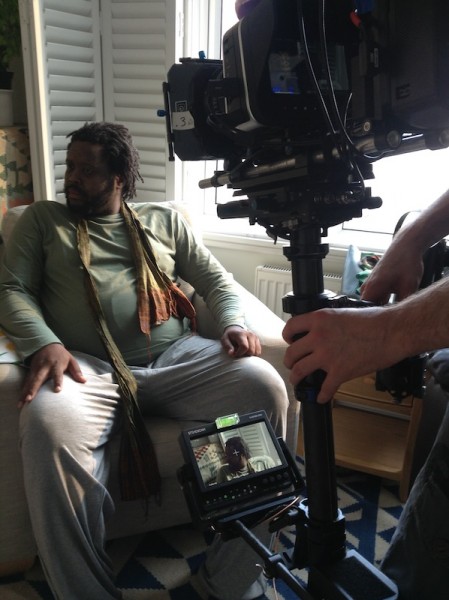 4:31pm We frame up the actor, Sibusiso, in position to check how the make-up looks under the right lighting.
4:31pm We frame up the actor, Sibusiso, in position to check how the make-up looks under the right lighting.
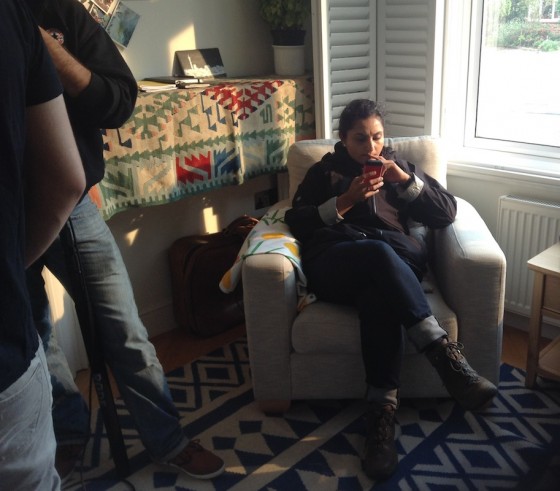 4:38pm Dimple, the spark, sits in while Sibusiso returns to make-up for tweaks, and I tweak my lighting.
4:38pm Dimple, the spark, sits in while Sibusiso returns to make-up for tweaks, and I tweak my lighting.
 4:41pm I decide that the morning sunlight look I’m going for is too subtle, so I have Ben replace the HMI’s half CTO gel with full CTO.
4:41pm I decide that the morning sunlight look I’m going for is too subtle, so I have Ben replace the HMI’s half CTO gel with full CTO.
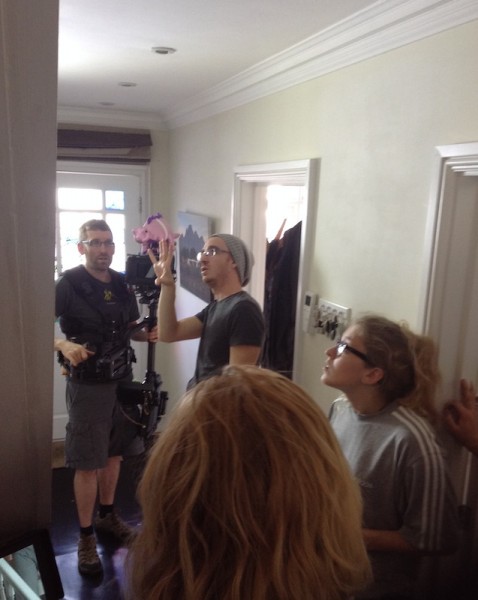 4:44pm Rupert and James finesse the camera move. When the make-up artist, Carly, is happy, we start shooting.
4:44pm Rupert and James finesse the camera move. When the make-up artist, Carly, is happy, we start shooting.
 4:44pm I sit back and watch the monitor, giving a note or two to Rupert after the first take.
4:44pm I sit back and watch the monitor, giving a note or two to Rupert after the first take.
 4:57pm With the Steadicam shot in the can, we select a lens and position for the next shot, a wide.
4:57pm With the Steadicam shot in the can, we select a lens and position for the next shot, a wide.
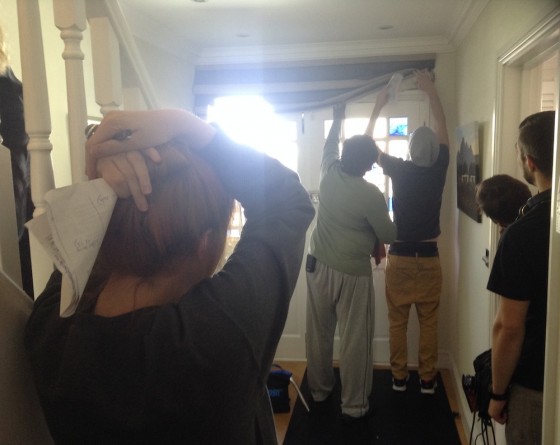 4:59pm Activity on set pauses while James catches a spider that is freaking out some of the crew.
4:59pm Activity on set pauses while James catches a spider that is freaking out some of the crew.
 5:04pm I squeeze myself in behind the camera, which is set up on sticks on the stairs, ready to shoot the wide. James gives some final direction to Lasharne, the actress, before we shoot the first take.
5:04pm I squeeze myself in behind the camera, which is set up on sticks on the stairs, ready to shoot the wide. James gives some final direction to Lasharne, the actress, before we shoot the first take.
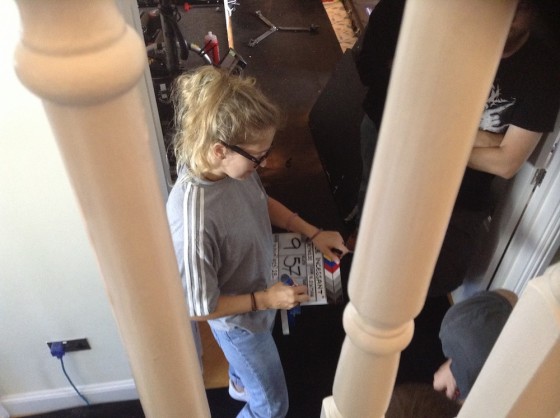 5:05pm Nat prepares the clapperboard for the next take.
5:05pm Nat prepares the clapperboard for the next take.
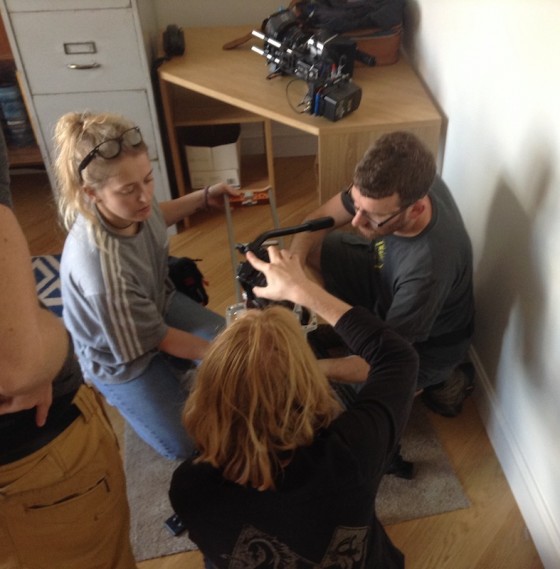 5:12pm The camera team set up the slider for the third set-up.
5:12pm The camera team set up the slider for the third set-up.
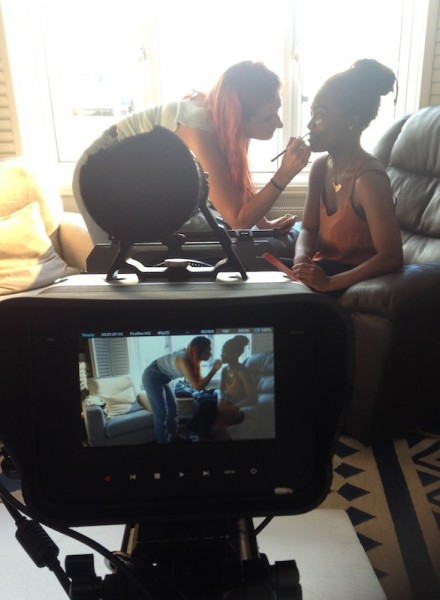 5:32pm Carly does final checks on Lasharne’s make-up.
5:32pm Carly does final checks on Lasharne’s make-up.
 5:32pm For this set-up I’m using a polyboard under the camera in an effort to raise the room’s ambient light level closer to the burnt-out view through the window.
5:32pm For this set-up I’m using a polyboard under the camera in an effort to raise the room’s ambient light level closer to the burnt-out view through the window.
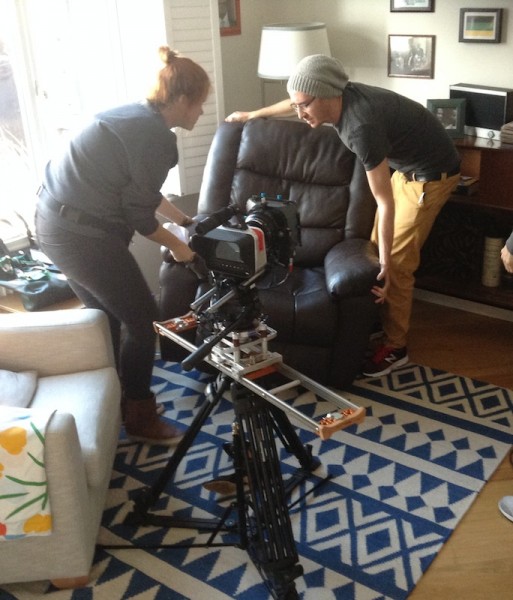 6:25pm Mari and James adjust an armchair to better suit the next set-up, another slider shot.
6:25pm Mari and James adjust an armchair to better suit the next set-up, another slider shot.
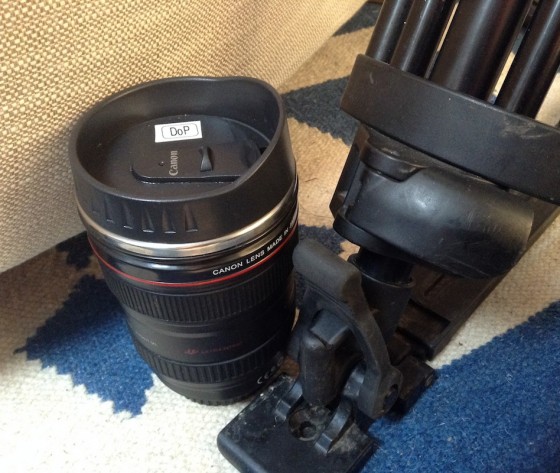 7:12pm Cunningly disguised as a lens, my cup of tea sits in easy reach beside the tripod.
7:12pm Cunningly disguised as a lens, my cup of tea sits in easy reach beside the tripod.
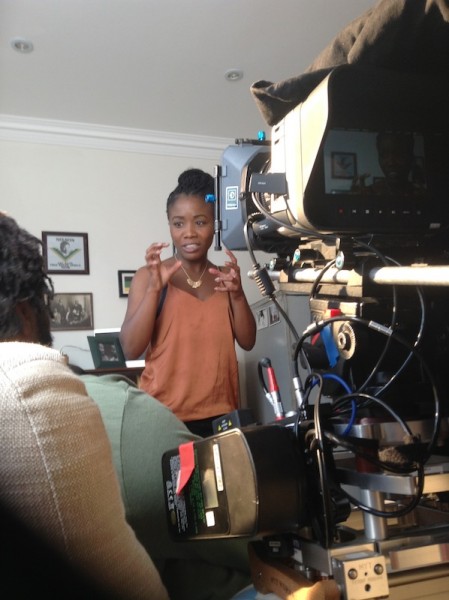 7:12pm We do a camera rehearsal to see if the set-up can accommodate Lasharne standing up, and it can. Max will move the slider while I control pan and tilt, and Rupert pulls focus remotely.
7:12pm We do a camera rehearsal to see if the set-up can accommodate Lasharne standing up, and it can. Max will move the slider while I control pan and tilt, and Rupert pulls focus remotely.
 8:13pm As the daylight starts to fade, we complete the scene and break for ‘lunch’. The food is quickly devoured.
8:13pm As the daylight starts to fade, we complete the scene and break for ‘lunch’. The food is quickly devoured.
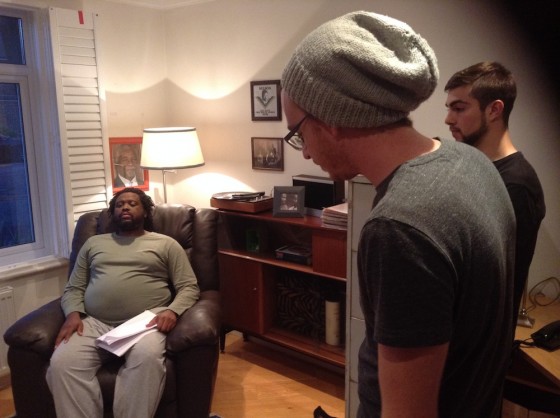 8:14pm We assemble on set again to watch a block through of the nighttime scene.
8:14pm We assemble on set again to watch a block through of the nighttime scene.
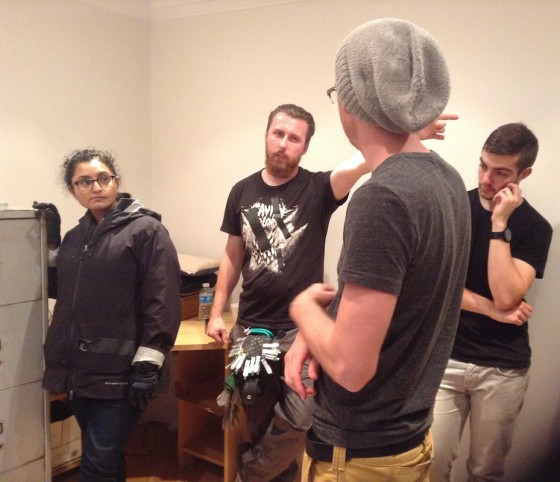 8:21pm Ben discusses a car headlight effect which James wants for the scene.
8:21pm Ben discusses a car headlight effect which James wants for the scene.
 8:24pm We clear the set to allow Jorge, the art director, to dress it. I check my notes for the scene.
8:24pm We clear the set to allow Jorge, the art director, to dress it. I check my notes for the scene.
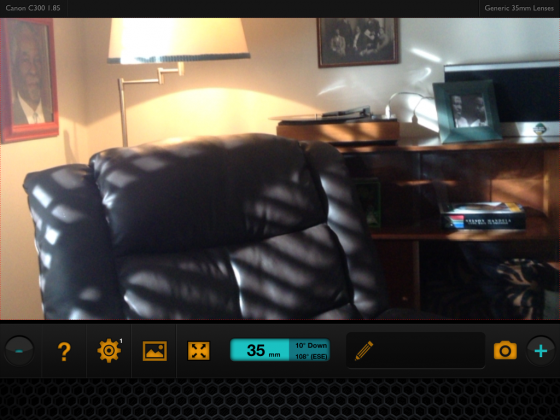 8:29pm Once Jorge has done his thing, James and I pick a lens and position for the first set-up. By this point most of the lighting has been done, except this…
8:29pm Once Jorge has done his thing, James and I pick a lens and position for the first set-up. By this point most of the lighting has been done, except this…
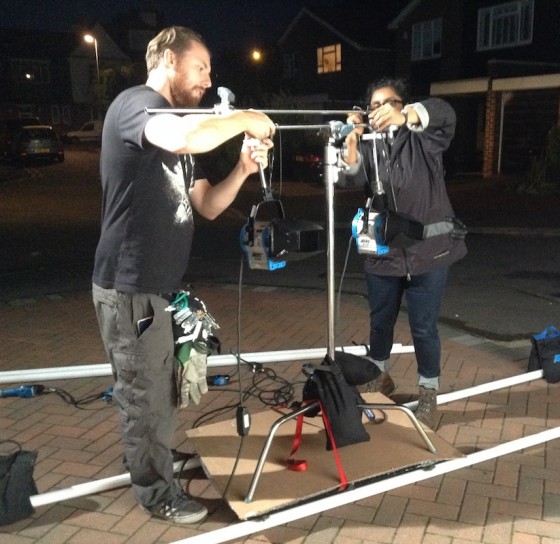 8:50pm Ben and Dimple construct a car headlight rig using two 300W tungsten fresnels mounted on a camera a dolly.
8:50pm Ben and Dimple construct a car headlight rig using two 300W tungsten fresnels mounted on a camera a dolly.
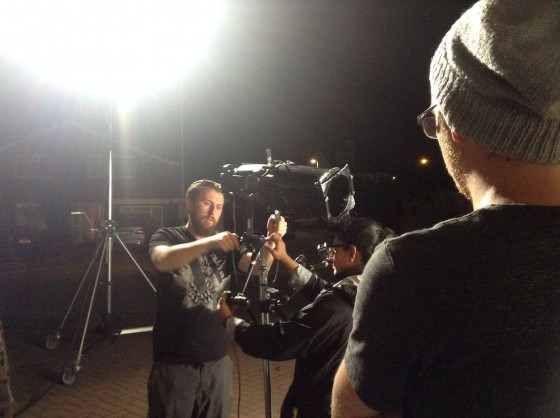 9:10pm The 300s prove too dim and the dolly too flimsy, so instead a Source 4 is rigged to Rupert’s Magliner.
9:10pm The 300s prove too dim and the dolly too flimsy, so instead a Source 4 is rigged to Rupert’s Magliner.
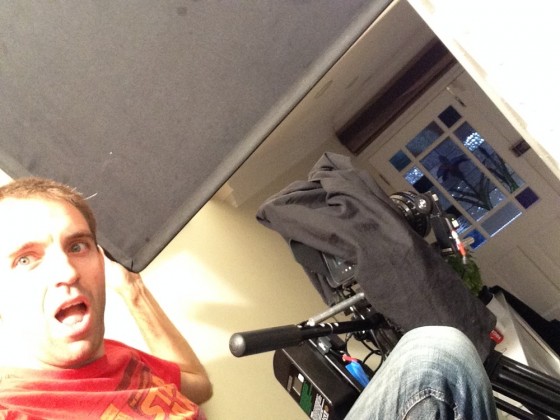 10:29pm The night scene is deliberately designed to echo the day scene, so I’m soon back on the stairs for a wide shot.
10:29pm The night scene is deliberately designed to echo the day scene, so I’m soon back on the stairs for a wide shot.
 12:46am We carry on with the scene, getting some very cool shots in the can, before wrapping a little after midnight. The kit is packed away in the living room, ready to load into the van tomorrow. Cider and sleep beckon.
12:46am We carry on with the scene, getting some very cool shots in the can, before wrapping a little after midnight. The kit is packed away in the living room, ready to load into the van tomorrow. Cider and sleep beckon.
Synced: The Japan Shoot – Part 4

This is the final instalment looking back at the whirlwind shoot I DPed in Japan at the start of this month. Part 1 looked at the equipment package, Part 2 covered an interior scene, and Part 3 covered night exteriors.
By the time we wrapped those night exteriors it was about 4:30am and starting to get light. After some well-earned sleep, we reconvened at 3pm to shoot the daylight exterior scene in front of Himeji Castle – featured in You Only Live Twice as a Ninja training school.
The first shot had to start with a picture postcard composition of the castle and a martial artist, then pan to reveal Daisy and a crowd watching her, while still keeping the castle in. This took some considerable time to set up, carefully placing all the extras. To balance the opening composition, I framed it with a tree in the foreground. This is the kind of thing you have to look out for as cinematographer, because simply shooting your cast in front of a landmark can result in a very flat image if there aren’t other elements in the frame to add depth.

After watching the initial blocking, I requested that everything be flopped in order to place Sydney in direct sunlight and Daisy in backlight. I knew that the backlight would look fantastic on Daisy’s hair – especially as the sun was very low by the time we got to her CU – and we could fill in her face with flattering bounce from a big white sign that the ever-resourceful Keisuke had brought along.
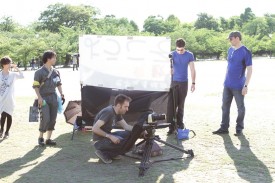
Masculine facial features tend to look better in harder, direct light, which is why I was happy to face Sydney into the sun. (There’s more to it than that though, and I’ll be debating the ethics of lighting men and women differently in an upcoming post.) However, for the first take of Sydney’s CU, worried about shine and squinting, I chickened out of the hardlight and put up a sheet of Full Frost to soften it. For the second take I got rid of it, which made for better lighting continuity with the wider shots, but left Sydney looking very shiny. There’s only so much powder can do when someone’s looking straight into the setting sun. I’ll be interested to see which one Devon prefers in the edit, although his decision will likely be based on performance rather than light and shine! A good colourist can probably reduce the shine anyway. If only I’d had 1/4 or 1/2 Frost to get the best of both worlds.
Judging when to shoot the various angles in your scene is an important part of a DP’s job for day exterior work, and especially so at Golden Hour. Devon wanted to shoot Sydney’s CU before Daisy’s, his logic being that if we lost the sun before we shot Daisy then it wouldn’t matter because her face was in shadow anyway. Knowing that I was probably going to diffuse Sydney’s light, I felt the greater priority was capturing the lovely backlight on Daisy, and so asked to shoot her first.
Anyway, when the sun went down, that was a wrap for the brief but intense Japan shoot. Many thanks to Devon and co for bringing me along, and to the people of Himeji for welcoming us so warmly.
Synced: The Japan Shoot – Part 3

Continuing the story of lensing the sci-fi feature Synced’s Japanese scenes earlier this month. In part 1 I looked at the prep, and part 2 covered an interior scene.
Next up, after dark, was a street scene with the beautiful Himeji Castle visible in the distance. The castle was already lit up by spotlights, but while the street had a fair bit of existing lighting, that wasn’t bright enough to shoot under. The scene was a slow chase in which the trio of heroes, one of them wounded, is slowly but menacingly pursued by the limping villain. This would be captured primarily in tracking shots, filmed from the back of a small pick-up truck pushed by the crew to avoid engine noise spoiling the soundtrack.


Employing my standard approach to night exteriors, I had the crew set up the 575W HMI as backlight, tucked around a corner. When we came to do the reverse shot, the HMI was moved to the opposite end of the street. It glared horrendously off some windows and shiny tiling, but with the time and equipment available I could see no way to remedy this. The lamp really needed more height, but I hadn’t hired a double wind-up stand because it wouldn’t have fitted in the car.
Three of the LitePanels were spaced along the street as sidelights, suggesting additional off-camera streetlamps. The furthest one, illuminating the villain on his first appearance, I gelled with Light Straw to separate him from the heroes.
The fourth LitePanel, with diffusion and egg crate fitted, was mounted on the pick-up truck behind the camera, providing a constant low level of fill.
Keisuke’s little LED panel was gelled red and wedged into a shop doorway to lend a sinister tone to a key moment in the scene.
The scene ends with two of the heroes entering a building. There was some existing practical lighting around this doorway which I asked to be turned on, and this proved sufficient to illuminate the characters as they approached and entered the door.

The final scene of the night took place in a quaint little alleyway. Cool blue streetlamps contrasted nicely with a halogen security light, but the former were too frontal and flat, while the latter was triggered by an infrared sensor – meaning it could go on and off annoyingly during takes.
So we flagged the main streetlamp and disabled the security light by gaffering the sensor, and I recreated the colour contrast of that lighting using our own lamps.
The houses on either side had convenient ledges above the windows, perfect for placing LitePanels on. So two panels became 3/4 quarter backlights from either side, set to 5,600K.
The third panel, set to 3,200K, was hidden behind a gate to light some of the background and edge the actors a little before they got in front of the other backlights. (I left the existing practicals to light the deep background.)
The fourth and final panel, set to 4,500K and gelled with Light Straw, blasted out of the door the actors came out of, matching to the light in the last part of the kitchen scene.
Near the end of the scene, the master shot becomes a two-shot of Ollie and Daisy, and the two 3/4 quarter backlights serve as a classic cross-backlighting set-up.
For Daisy’s close-up, since she was quite close to the wall and therefore quite dark, I tweaked the lights heavily. I brought one of the backlight panels much closer, bouncing it off the cream-coloured wall next to Ollie to serve as her key, and switched the second backlight to the opposite side of camera to balance it out. I also added a ‘health bounce’ reflector, ensuring she had a nice big eyelight to underline her vulnerability in the scene.
In the fourth and final part I’ll be looking at the day exterior scene we shot in the grounds of Himeji Castle.
Synced: The Japan Shoot – Part 2
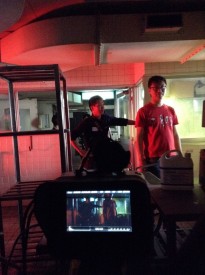
In part 1 I described how we arrived at a lighting package and monitoring solution for the Japanese leg of this sci-fi feature shoot.
The first scene to go before the camera was the night interior, set in a hospital kitchen. The location was blacked out by the Japanese crew with incredible efficiency, so we could shoot it in the afternoon. Unable to light through the windows, I hid LitePanels in alcoves and around corners. They were all set to 5,600K and most were gelled with half CTB to appear very cool when shot with a white balance of 4,500K. The idea was to give the impression of streetlights – many of which are cool blue in Himeji – spilling into the dark, abandoned kitchen.
But Japan is a colourful place, and at night all hues of lighting are seen from signs and shopfronts as well as streetlamps. So, behind the frosted glass door of a locker room at the back of the master shot, I set up the HMI, gelled with Light Straw to suggest an older sodium vapour streetlight.
For a third layer of colour, I gelled one of the LitePanels red.
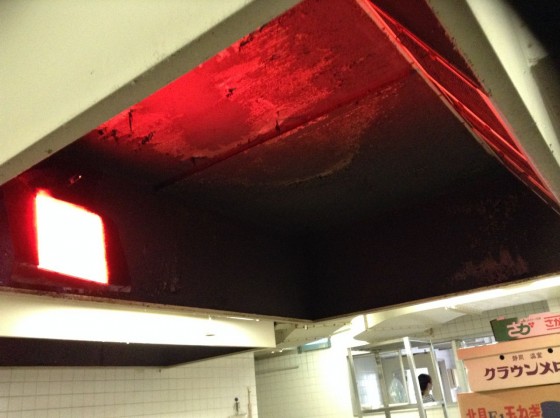
As the action progressed around the room, shot by shot, I moved the panels to new areas when the old areas ceased to be in frame, always taking care that the light was hitting the actors from the sides or from behind, never from the direction of the camera. (This would have made for flat lighting, a massive no-no in cinematography.) At one point I needed one more lamp than we had, and Keisuke saved the day with a small but very bright LED panel of his own.

In part 3 I’ll be breaking down the night exterior scenes.
Synced: The Japan Shoot – Part 1
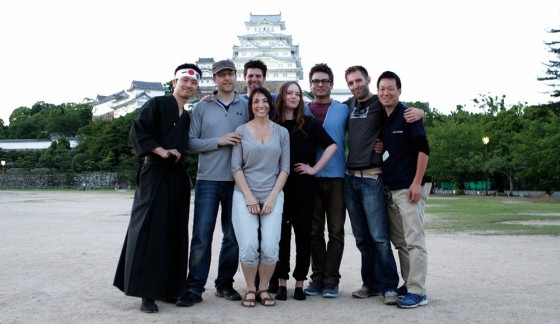
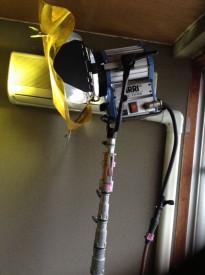
On Wednesday May 27th I got a call from my friend and actor Oliver Park, saying he was flying to Japan on Sunday for a shoot and did I want to come as DP? He was playing the leading man in Synced, a sci-fi feature film directed and co-written by Devon Avery, and after a month of shooting in Glasgow, the existing DP had opted not to take part in the Asian shoot.
On Friday night my plane ticket came through, at midnight on Sunday I was changing planes in Qatar, and on Monday afternoon (local time) I was in Osaka. The following morning saw me at Arc System, a very helpful lighting rental house, with Devon, his wife/multi-talented assistant Justine and a couple of the Japanese crew. With two night exteriors and a night interior as well as a day exterior scene, a reasonable amount of kit was needed.
The mains electricity in Japan is 100V, 60Hz, so very similar to the US – and indeed the plugs and sockets are identical. But the killer is that you can only draw 7A per socket. That’s a maximum of 700W, as opposed to over 3,000W from a UK socket.

So the biggest lamp we could hire without needing a generator was a 575W HMI. With one of those in the bag, I figured it was best to fill out the package with battery-powered lamps, and so hired four 1’x1′ Bi-Color LitePanels. Although I’m still not 100% sold on the colour rendition of any LED panels (even LitePanels, which are amongst the best), there’s no denying they’re incredibly handy and quick to set up.
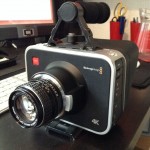
I would be shooting in 4K ProRes 422 HQ on my Blackmagic Production Camera, at 23.976fps. I initially stuck to two Canon L series lenses for continuity: Devon’s 24-70mm f2.8 and crew member Keisuke Ueda’s Canon L 50mm f1.4. Since I was constantly struggling to expose an image at the BMPC’s native 400 ISO, I later employed my Sigma 20mm f1.8 for faster wide shots, and I couldn’t resist trying my new Pentax 50mm f1.4, which performed beautifully at f1.7 and above, but did seem a touch soft when wide open.
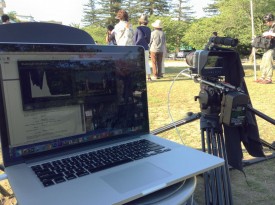
Regular readers will know of the trials and tribulations I’ve experienced getting a monitor signal out of my BMPC, with the result that I bought a 17″ Blackmagic SDI monitor last year. It was impossible to bring this to Japan, so instead – for the first time – I experimented with Thunderbolt monitoring. A runner was dispatched to buy a cable, and Devon installed the Blackmagic Camera package on his Macbook. This package includes Ultrascopes, which provides a live video view amongst other things, though annoyingly only in a pretty small window.
Whenever I turned the camera off or played anything back, the signal would be lost. To get it back, Devon would have to quit Ultrascopes and I’d have to switch to 25fps before he re-opened it. Only once it was re-opened could I switch back to 23.976fps. Please sort out that little bug, Blackmagic Design!
With the kit and workflow sorted, we travelled to Himeji (by bullet train, no less) ready to start shooting on Wednesday. Watch this space for part 2: shooting the kitchen scene.
Synced is copyright 2015 Empty Box Productions LLC.

